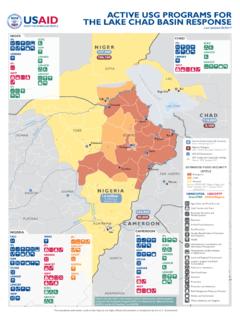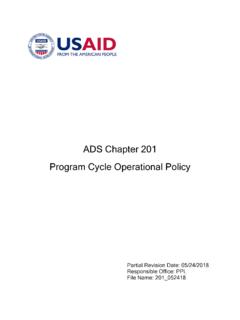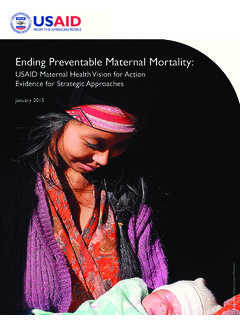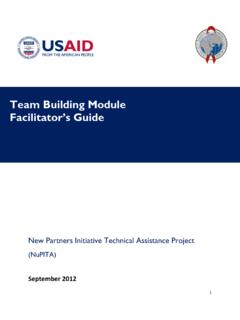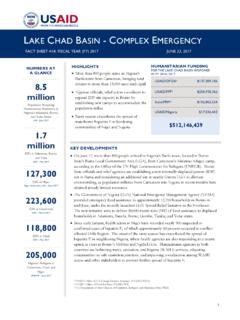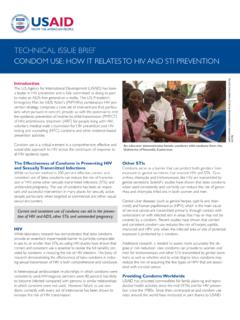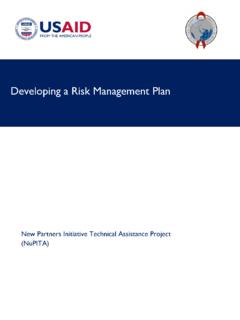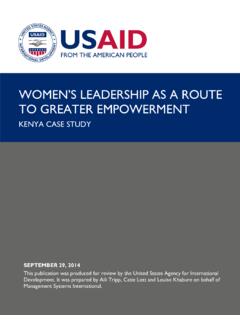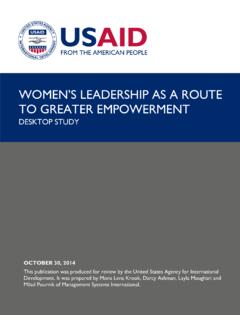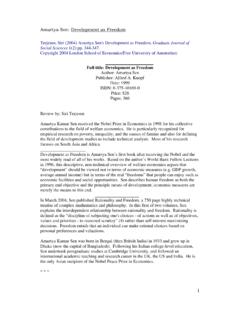Transcription of Kenya: Nutrition Profile
1 kenya : Nutrition Profile Malnutrition in childhood and pregnancy has many adverse consequences for child survival and long-term well-being. It also has far-reaching consequences for human capital, economic productivity, and national development overall. The consequences of malnutrition should be a significant concern for policymakers in kenya , where out of a total under-5 population of 7 million, million children (26 percent) are suffering from chronic malnutrition (stunting or low height-for-age) ( kenya National Bureau of Statistics (KNBS) et al.)
2 2015). In addition, although malnutrition indicators are improving, it is estimated that from 2010 2030 undernutrition will cost kenya approximately US$ billion in GDP due to losses in workforce productivity (USAID 2017a). Background kenya s economy grew rose by an estimated percent in 2016, making kenya one of the fastest-growing economies in Sub- saharan africa (World Bank 2017). This growth was supported by a stable macroeconomic environment, low oil prices, a rebound in tourism, strong remittance practices, and government-led infrastructure development. However, political turmoil during the presidential elections in 2017, in which at least 55 Kenyans died, may slow growth (World Bank 2017; USAID 2017b). Agriculture is the backbone of the economy and central to the government s development strategy, employing more than 75 percent of the workforce and accounting for more than a fourth of the country s gross domestic product (USAID 2017a).
3 However, agricultural productivity has been stagnating in recent years due to frequent droughts, floods, and climate change; only about 20 percent of Kenyan land is suitable for farming. Maximum yields have not been reached, indicating the potential for substantial increases in productivity (USAID 2017a). Currently, kenya ranks 125th out of 157 countries in progress toward meeting the Sustainable Development Goals (SDGs) (Sachs et al. 2017). According to the most recent Demographic and Health Survey (DHS) in kenya (2014), the maternal mortality ratio is 362 per 100,000 live births. Although kenya has made significant strides in reducing neonatal, infant, child, and under-5 mortality, one in every 26 Kenyan children will die before reaching 1 year of age, and one in every 19 will not survive to his/her fifth birthday (KNBS et al.)
4 2015). Nutrition and Food Security Situation kenya continues to face severe food insecurity with million people in 2017 suffering from acute food insecurity (USAID 2017a). Persistent droughts, high costs of domestic food production, high global food prices, low purchasing power, and displacement of farmers during election violence in 2007 all contribute to food insecurity in the nation (USAID 2017a). kenya has made substantive strides in reducing the prevalence of stunting nationally, falling from 35 percent in 2008 to 26 percent in 2014 (KNBS et al. 2015; KNBS and ICF Macro 2010). Stunting is highest in the Coast, Eastern, and Rift Valley regions. It is most prevalent among children 18 23 months, indicating that poor complementary feeding and hygiene and sanitation practices are likely contributors to stunting in that age group.
5 While acute malnutrition (wasting or low weight-for-height) among children under 5 years is relatively low nationally (4 percent), it reaches almost 14 percent in North Eastern region (KNBS et al. 2015). Children of mothers who did not complete primary school or who have no education are more likely to be stunted at 34 percent and 31 percent, respectively, than children of mothers with a secondary or higher education at 17 percent. Disparities are also apparent among wealth quintiles. Fourteen percent of children in the highest wealth quintile are stunted, while 36 percent of children in the lowest wealth quintile are stunted (KNBS et al. 2015). Inadequate infant and young child feeding practices also contribute to high rates of malnutrition in the country.
6 Although exclusive breastfeeding practices have increased dramatically, from 32 percent in 2008 to 61 percent in 2014, only 42 percent of infants 4 5 months of age are still exclusively breastfed and only 62 percent of mothers initiate breastfeeding within an hour of birth (KNBS et al. 2015; KNBS and ICF Macro 2010). In addition, complementary feeding practices are poor in kenya , as only 22 percent of breastfed children 6 23 months received a minimum acceptable diet (KNBS et al. 2015). Vitamin A deficiency is relatively low at 9 percent in children under 5 years. However, only 35 percent of children 6 23 months consumed vitamin A-rich foods and 16 percent consumed iron-rich foods in the past day (KNBS et al. 2015; MOH 2011). Maternal and child anemia are widely prevalent in kenya , with 36 percent of children under 5 years and 42 percent of pregnant women suffering from anemia (KNBS et al.)
7 2015; National Malaria Control Programme (NMCP kenya et al. 2016). Adolescent girls 15 19 years in kenya are the most malnourished group among women of reproductive age; 17 percent have a body mass index < , compared to 6 percent of women 40 49 years of age (KNBS et al. 2015). Although undernutrition is still an issue in kenya , overweight and obesity are also becoming a concern, with 33 percent of women overweight or obese (KNBS et al. 2015). kenya has one of the world s highest rates of population growth (USAID 2017a). The population has tripled in the past 35 years, straining the country s resources and leaving young people, especially women, particularly vulnerable to poverty and malnutrition (KNBS et al. 2015). Although the total fertility rate has reduced in the past 20 years (from in 1993 to in 2015), the adolescent fertility rate increased between the 2008 09 DHS and the 2014 DHS, from 36 to 40 percent (Central Bureau of Statistics (CBS) [ kenya ], et al.)
8 2004; KNBS and ICF Macro 2010; NMCP kenya et al. 2016). The high prevalence of adolescent pregnancy has serious consequences because, relative to older mothers, adolescent girls are more likely to be malnourished and have a low birth weight baby who is more likely to become malnourished, and be at increased risk of illness and death than those born to older mothers. The risk of stunting is 33 percent higher among first-born children of girls under 18 years in Sub- saharan africa , and as such, early motherhood is a key driver of malnutrition (Fink et al. 2014). kenya Nutrition Data (DHS 2008 2009 and 2014, MIS 2015, and NNS 2011) Population 2016 (UNICEF 2017) million Population under 5 years of age (0 59 months) 2016 (UNICEF 2017) 7 million DHS 2008 2009 DHS 2014 Prevalence of stunting among children under 5 years (0 59 months) 35% 26% Prevalence of underweight among children under 5 years (0 59 months) 16% 11% Prevalence of wasting among children under 5 years (0 59 months) 7% 4% Prevalence of low birth weight (less than kg) (of children whose birth weights are known) 6% 8% Prevalence of anemia among children 6 59 months 46% 36%1 Prevalence of anemia among women of reproductive age (15 49 years) (non-pregnant) 22%2 NA Prevalence of thinness among women of reproductive age (15 49 years) (BMI less than kg/m2)
9 12% 9% Prevalence of children 0 5 months exclusively breastfed 32% 61% Prevalence of children 4 5 months exclusively breastfed 13% 42% Prevalence of early initiation of breastfeeding ( put to the breast within 1 hour of birth) 58% 62% Prevalence of children who receive a pre-lacteal feed 42% 16% Prevalence of breastfed children 6 23 months receiving minimum acceptable diet 24% 22% 1 Data are from the 2015 Malaria Indicator Survey, not the 2014 DHS. 2 Data are from the 2011 National Nutrition Survey, not the 2008 2009 DHS. Updated February 2018 2 Prevalence of overweight among children under 5 years (0 59 months) 5% 4% Prevalence of overweight among women of reproductive age (15 49 years) 25% 33% Coverage of iron for pregnant women (for at least 90 days) 3% 8% Coverage of vitamin A supplements for children (6 59 months, in the last 6 months) 30% 72% Percentage of children 6 59 months living in households with iodized salt 98% 100% NA: Not Available Global and Regional Commitment to Nutrition and Agriculture kenya has made the following global and regional commitments to Nutrition and agriculture.
10 Year of Commitment Name Description 2012 Committing to Child Survival: A Promise Renewed Campaign kenya pledged to reduce under-5 mortality to 20 or fewer deaths per 1,000 live births by 2035 by reducing the leading preventable causes of child mortality, including undernutrition (A Promise Renewed 2017). 2012 Scaling Up Nutrition (SUN) Movement In 2012, kenya joined Scaling Up Nutrition (SUN), a global movement that unites national leaders, civil society, bilateral and multilateral organizations, donors, businesses, and researchers in a collective effort to improve Nutrition . Priorities for 2017 2018 include advocating for the finalization and dissemination of key bills in parliament ( , Food and Nutrition Security Bill and the Breastfeeding Bill), support for the dissemination and implementation of the Health Act 2017, and roll-out of the Nutrition financial tracking tool at the national and county levels, among others (SUN 2017).
